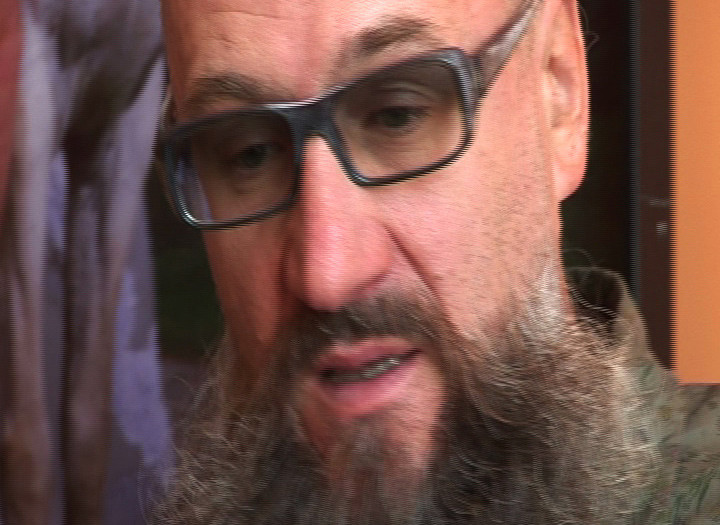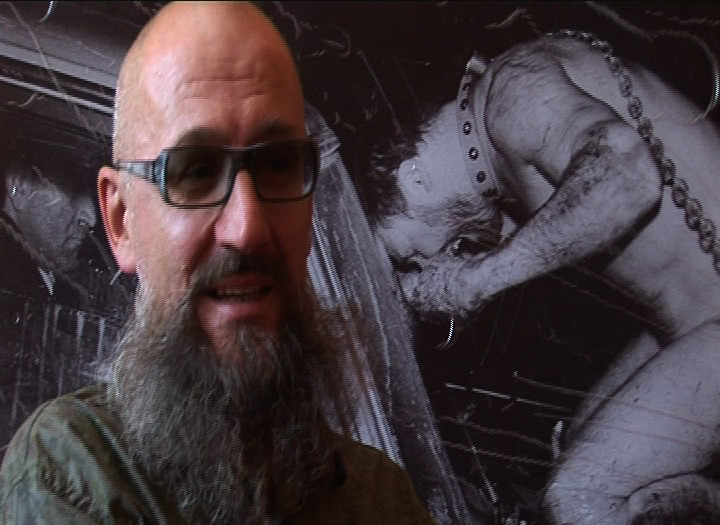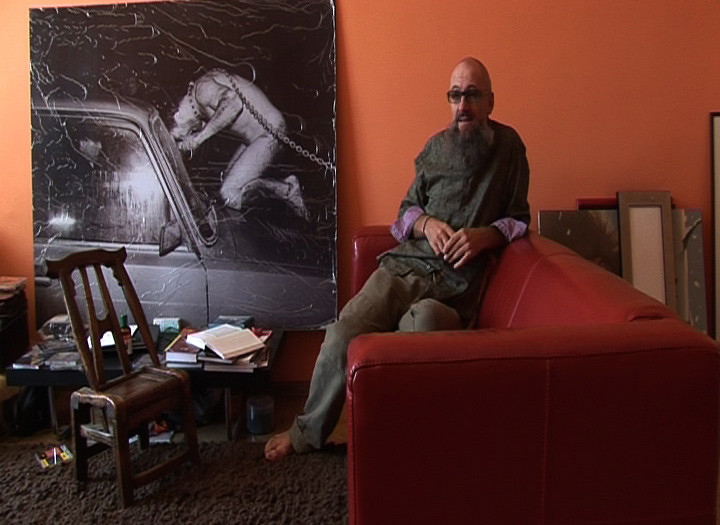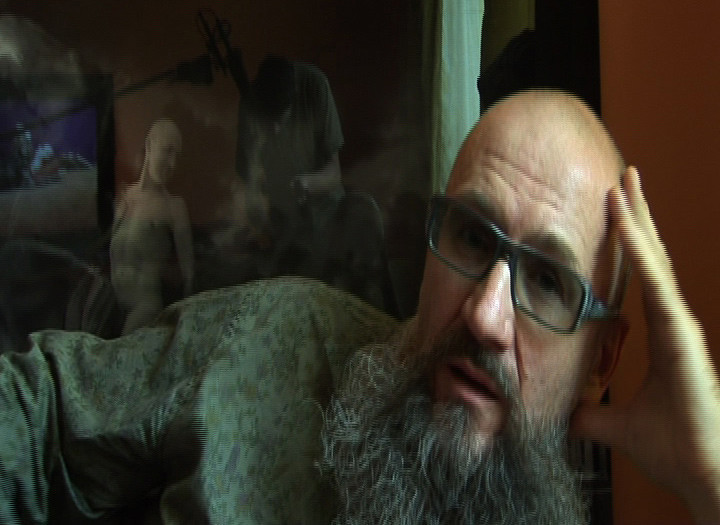Oleg Kulik – Сhallenge and Provocation
original title: Oleg Kulik - vyzov i provocacia
2008, DCP, 70 min., Russian
CATEGORIES : Documentary, Debut
DOCUMENTARY CATEGORIES : Art / Music / Literature / Culture, Portraits
COUNTRY: Russia
PRODUCTION : BUDGET : -
CAST
Oleg Kulik, Ludmila Bredikhina
CREW
Director : Screenplay : Evgeny MittaCinematographer : Alexander Kuznetsov
Producers : Giya Lordkipanidze, Alexander Shein, Victor Taknov, Evgeny Mitta
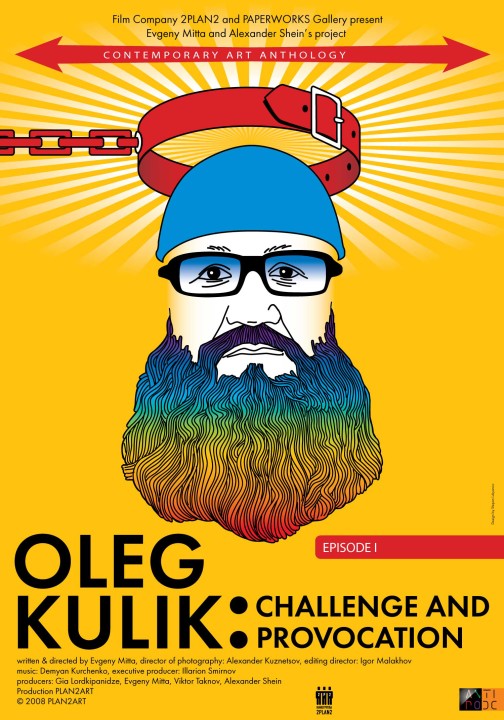
SYNOPSIS
Oleg Kulik is a provincial artist, a beginner, who comes to Moscow and dreams to “conquer the capital”. He wishes to establish himself as a sculptor. He passes several years in his workshop situated in the basement where he creates conceptual glass sculptures. He tries to show them at exhibitions but no one shows any sign of interest for his art. The public does not comprehend transparent art objects and the critics do not recognize his ideas. Disappointed, he stops making any sculpture. He asks himself how to make his voice audible to the indifferent crowd. Social role of the artist in the contemporary world become Kulik’s zone of experiments.
The artist’s block has come. His living situation is miserable. In desperate search of means of subsistence and artistic milieu Kulik finds a curator job in Ridzhin’s Gallery, one of the first private art galleries established in Moscow in the beginning of 90s. He meets young underground artists whose creations he exhibits in the gallery. Kulik helps them to formulate their ideas in a more clear way and find original exhibition solutions. For instance, in Anatoly Osmolovski’s installation, live leopards walk the gallery as visitors while the public stays locked behind the bars as animals. The exhibition makes a sensation, the artist becomes famous and his success makes Kulik more visible. He finds people who share his views, he finds an impulse to work. He wishes to establish himself as an artist.
Kulik decides to adopt the genre of performance – direct contact with the public. It is in the same time a challenge to his own ego and a provocation of the society whose reaction he awaits. Outside his window he sees the chaos of post-Soviet Russia and savage customs of the new brutish capitalism. Inspired by the reality, the artist invents the image of a mad dog, intending to transform himself into the animal during the performance. He would stay on a chain, blocking the entrance to the Gelman’s gallery and not letting any visitor inside. Kulik believes it would be a metaphore, reflecting the passion for the art that consumes artists. The gallery director likes the idea and sets a date for the performance.
Short before his appearance before the public, Kulik is seized with fear and confusion, he wishes to refuse, it seems to him that a failure would finish all his hopes to become an actual artist. Finally, the gallery director stops his doubts and kicks him out, naked, on a chain, towards the public and the journalists who wait for him. He feels lost and hopeless but suddenly puts himself together and really transforms into a mad dog. He attacks a car passing by, almost falling under its wheels; he rushes to people and knocks down several journalists – entering, according to his own words, the state of transgression. The people are shocked – they cannot see art in this action.
When Kulik comes to his senses, he believes his action was an utter failure. But his friends and the gallery director are ecstatic, they persuade him that he had said a new word in art and he should go on. Kulik continues his actions and shortly becomes a leader of the new artistic trend, the Moscow actionism. The artist asks himself what should he do to be accepted by wide public.
Kulik understands that to get a real reputation, an artist must take part in international exhibitions. If he does not, he will not become visible. But does anyone in the West need the unknown man-dog from Russia?
Finally, Kulik manages to find a way to a large art event in Zurich, Switzerland. He repeats his performance. Naked, on chain, he blocks the entrance to the city exhibition hall during the inauguration of the exposition. He bites several art critics, is arrested by the authorities and his scandalous performance is described in the international press. Kulik’s name is now familiar to everyone. He is a welcome visitor to great expositions all over the world.
Curators invite Kulik but ask him to be a good dog and not bite anyone. However, Kulik does not listen to them. He is true to his image and does not accept any compromise. There are new scandals, new meetings with the police and growing glory. After his European success, Kulik is invited to New York by the famous curator and gallery director Jeffrey Deitch. In the gallery, according to his idea, he must be in a big cage, interacting with the public. They are able to enter the cage if they wish. It is a hard trial for the artist, both physically and psychologically. During two weeks, Kulik and his visitors go through an incredible experience of communication that becomes a turning point for the artist’s self-discovery. At first suspicious, Kulik comes to a deep intuitive contact with the Other, overcoming any racial, gender and age limitations. His project, having started just as a case of shocking behaviour, comes to philosophic questions of interior liberty, border separating human being from animal and criticism of anthropocentricity. The spectator becomes participant of the artwork while the social role of the artist dominates. It is no coincidence that this action, named I bite America – America bites me – refers to the famous New York performance of a great shaman of contemporary art, Joseph Beuys: I love America-America loves me.

